Minimally Invasive Arthroscopy for Elbow Dysplasia in Dogs
Arthroscopy for Elbow Dysplasia in Dogs
Helping dogs overcome elbow pain and front leg lameness with expert minimally invasive surgery.
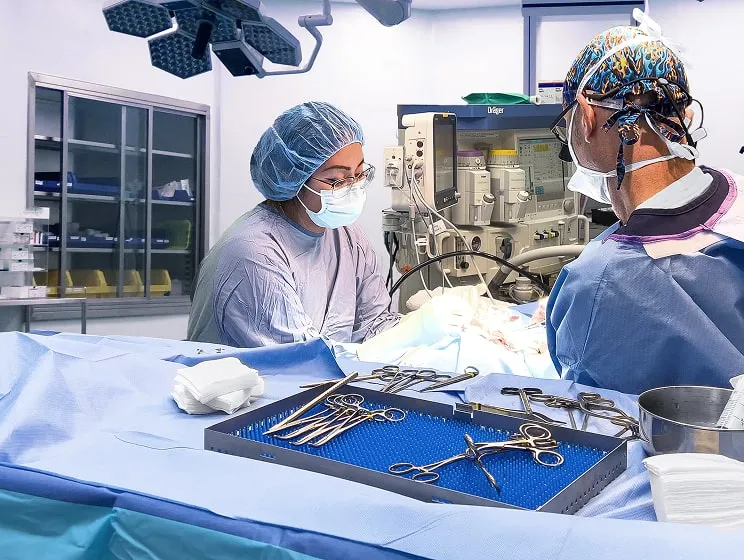
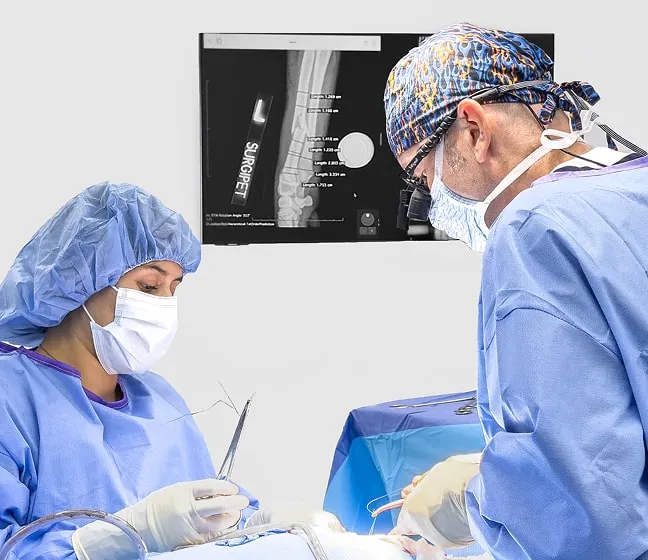
Understanding Elbow Dysplasia
Elbow dysplasia is a common cause of limping in a front leg in dogs, especially in large breeds. It results from abnormal development of the elbow joint, leading to pain, arthritis, and difficulty using the affected leg.
Arthroscopy offers the most precise and least invasive treatment for elbow dysplasia in dogs - helping your pet heal faster and stay active longer.
 Minimally invasive approach.
Minimally invasive approach. Slows arthritis progression.
Slows arthritis progression. Helps your dog return to an active lifestyle.
Helps your dog return to an active lifestyle.
Serving San Diego, Orange County, Los Angeles, and Riverside
Elbow Arthroscopy Experts
Elbow dysplasia is one of the most common reasons for elbow surgery at SurgiPet, second only to fractures. While medical management can offer short-term relief, most dogs eventually require surgery to address the condition.
If surgery is necessary, the all-inclusive package fee for elbow dysplasia surgery at SurgiPet covers everything from the initial consultation to post-surgical rechecks and x-rays and offers 30-40% savings compared to large veterinary hospitals' charges.

Your Dog’s Elbow Arthroscopy Journey
Initial Consultation
We don’t rush - each consultation includes a full history, a careful hands-on exam of your dog, and time to talk through your goals, concerns, and what matters most to you.
Surgery Day
Experience counts! Our surgeon has performed thousands of orthopedic surgeries over the course of his professional career. With that experience, your dog is in the best hands.
Going Home
Your pet will go home comfortable, fully recovered from anesthesia, and able to walk. You will receive printed instructions, and dedicated post-operative support is available 7 days a week-including weekends.
Providing peace of mind and comfort
What to Expect After Elbow Arthroscopy Surgery
Most dogs recover quickly after elbow arthroscopy. Mild stiffness or lameness is normal at first, but with proper rest and guided activity, your dog will gradually regain comfort and mobility.
We provide 7-days-a-week support to guide you through every step of recovery.
Tips for Recovery:
✔ Follow all activity and exercise restrictions closely.
✔ Return for scheduled rechecks - they’re covered in the surgery fee.
✔ Contact us with any concerns - the surgeon is just a phone call away.

The Safest pet anesthesia. For Every Pet. In Every way.
Ensure your pet’s safety with expert anesthesia care tailored to their specific needs, managed by a board-certified veterinary anesthesiologist.
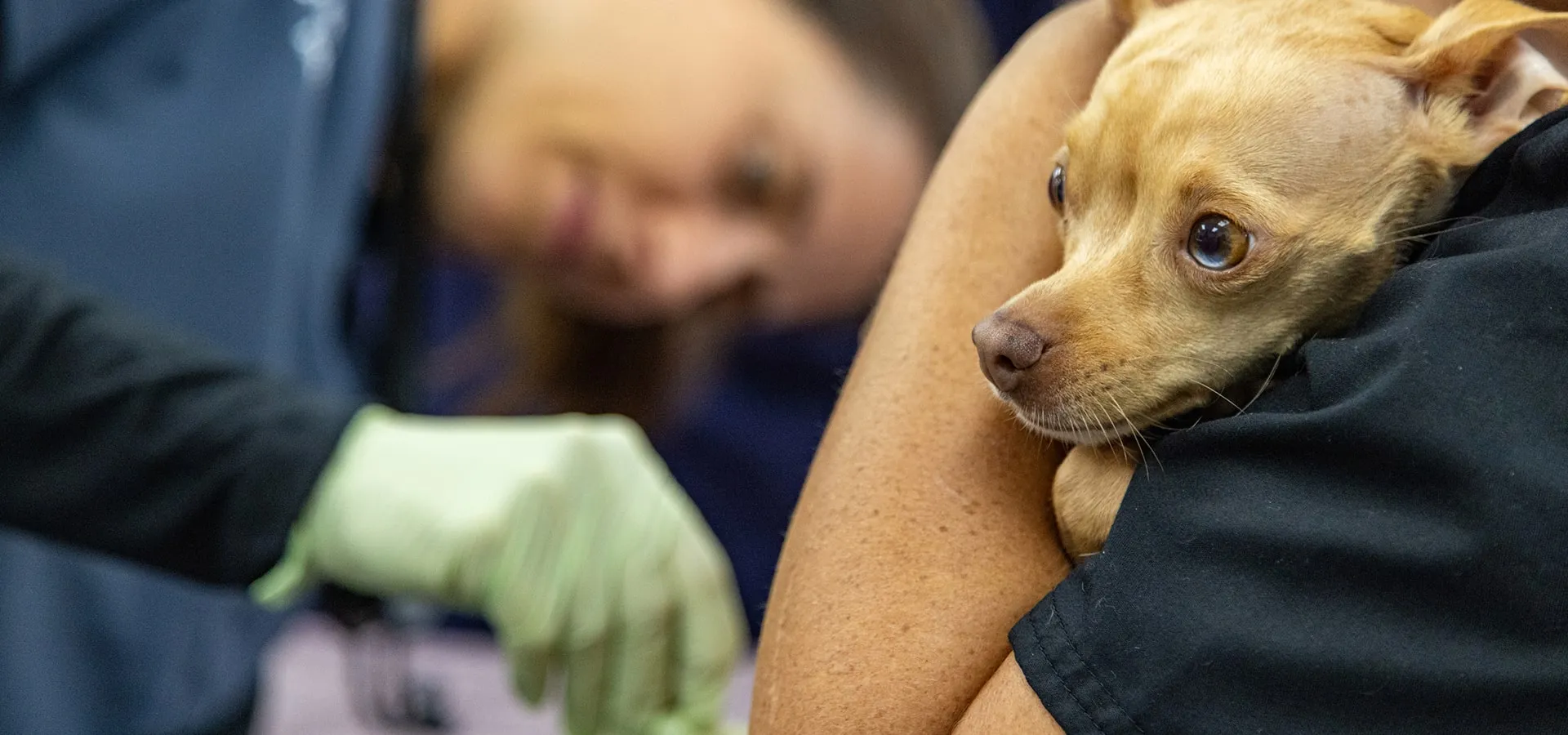
Meet the Dedicated Team Behind Our Success

Dr. Wypart has twenty years of experience with various soft tissue and orthopedic surgeries. After graduating from veterinary school, he completed rigorous specialty training in veterinary surgery.
Dr. Wypart is a highly skilled veterinarian with over two decades of experience in orthopedic and soft tissue surgery. He earned his veterinary degree from the Warsaw University of Life Sciences and completed advanced specialty training in veterinary surgery at the European University of Environmental and Life Sciences. His clinical skills have been shaped by extensive international practice across Europe and North America.
Since relocating to San Diego in 2012, Dr. Wypart has become known for his surgical expertise, particularly in orthopedic procedures involving joint trauma, complex fractures, and advanced soft tissue techniques. A member of the Veterinary Orthopedic Society, he has performed over 1,000 successful TPLO surgeries and remains actively engaged in continuing education focused on fracture management, joint disease, and advanced soft tissue procedures.
Dr. Wypart founded SurgiPet to make high-quality, specialized surgical care more accessible and affordable for pets in San Diego and surrounding communities, with a focus on procedures like TPLO for cranial cruciate ligament repair.
Outside of surgery, Dr. Wypart enjoys growing vegetables in his backyard, perfecting new soup recipes, and hiking Potato Chip Mountain.

Dr. Margaret Wypart, DACVAA, is a board-certified veterinary anesthesiologist with over fifteen years of experience. She ensures pets stay safe, stable, and comfortable - just as human anesthesiologists do for people.
Dr. Margaret Wypart, DACVAA is the Medical Director and co-founder of SurgiPet, where she leads the development of advanced anesthesia protocols to ensure surgical safety and comfort for every patient. She has been dedicated to veterinary anesthesia for over a decade, having completed a competitive 3-year residency in Anesthesia and Pain Management at the University of Pennsylvania, an Ivy League school known for its highly respected veterinary training program.
One of only a few board-certified veterinary anesthesiologists practicing in San Diego County, Dr. Wypart’s clinical focus is entirely on keeping pets safe and pain-free during surgery. She specializes in ultrasound-guided nerve blocks to minimize discomfort and reduce reliance on systemic medications—allowing pets to wake up more smoothly and return home the same day. Her approach follows the principles of Enhanced Recovery After Surgery (ERAS), emphasizing proactive pain control, early mobility, and rapid return to function.
Her protocols have been adopted by practices across the region, reflecting her commitment to elevating anesthesia standards and improving surgical outcomes. She collaborates closely with primary care veterinarians and pet owners throughout San Diego County, offering individualized patient care, advanced consultation, and hands-on training for veterinary technicians.
Outside of work, Dr. Wypart enjoys hiking, skiing, and photography.
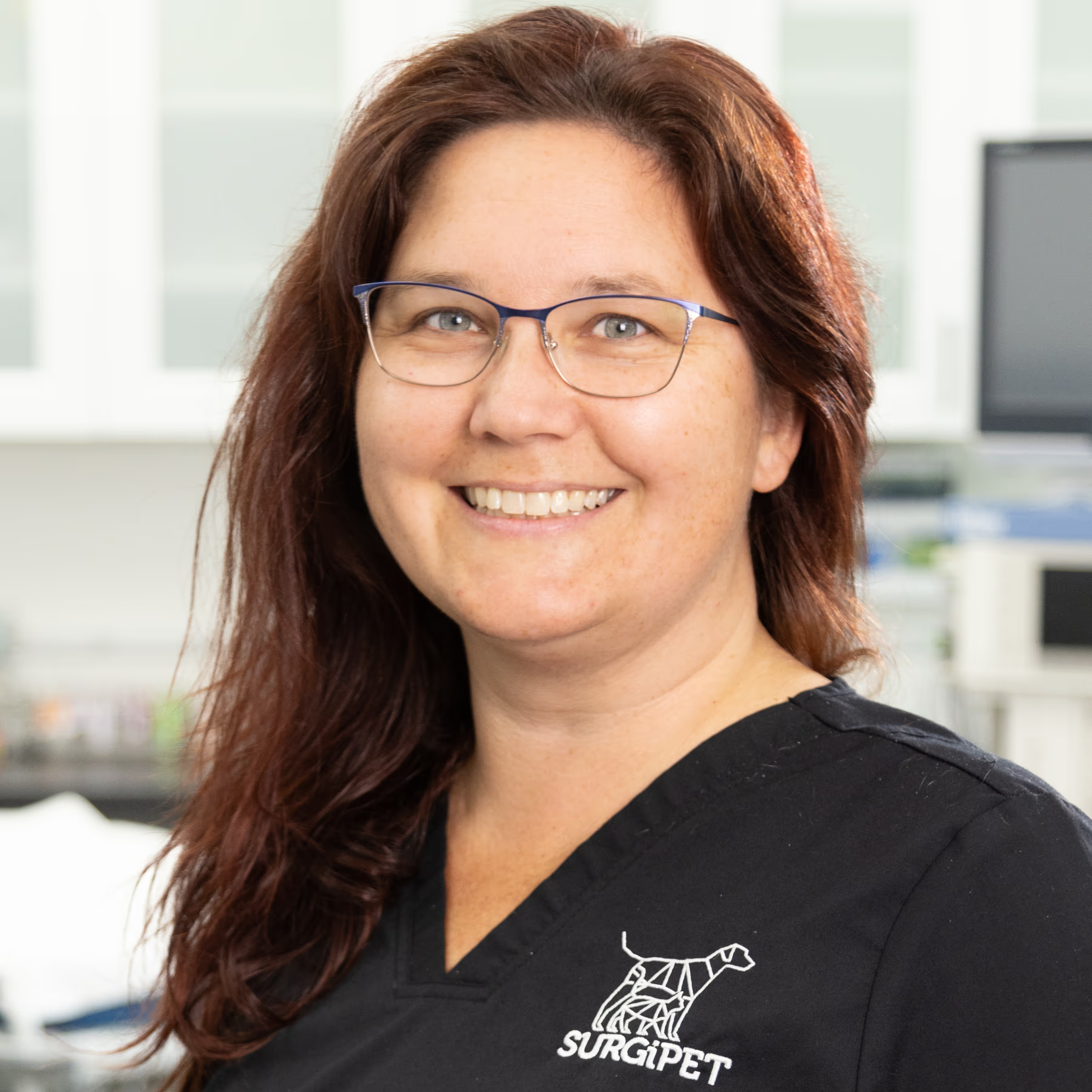
Amber has over two decades of experience as a Registered Veterinary Technician. One of her greatest joys is mentoring and training newer staff, sharing the passion for veterinary care that has driven her throughout her career.
Amber is a Registered Veterinary Technician and our Nursing Director, bringing more than 20 years of experience in veterinary medicine to our team. Most of Amber’s career has been spent in emergency and intensive care, where she developed strong skills in critical patient management, anesthesia, and team leadership. For the past two years, she has brought that expertise to our surgical center, where she focuses on ensuring a smooth experience for patients from admission through recovery and supporting our team in providing exceptional surgical nursing care.
Amber is passionate about creating a positive, collaborative environment for both her team and our clients. She believes that every patient deserves individualized, compassionate care and takes pride in building trust with the families who bring their pets to us. She also enjoys mentoring veterinary professionals and helping others grow within the field.
Outside of work, Amber loves spending time with her family and many pets, traveling in their RV, and curling up with a good book.
No surprises!
Transparent, All-inclusive Pricing for Surgery

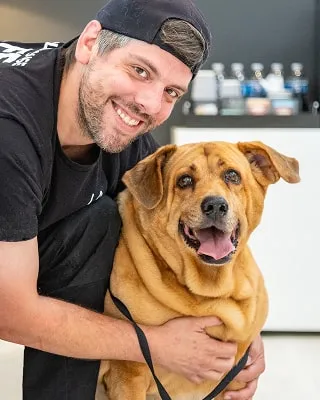
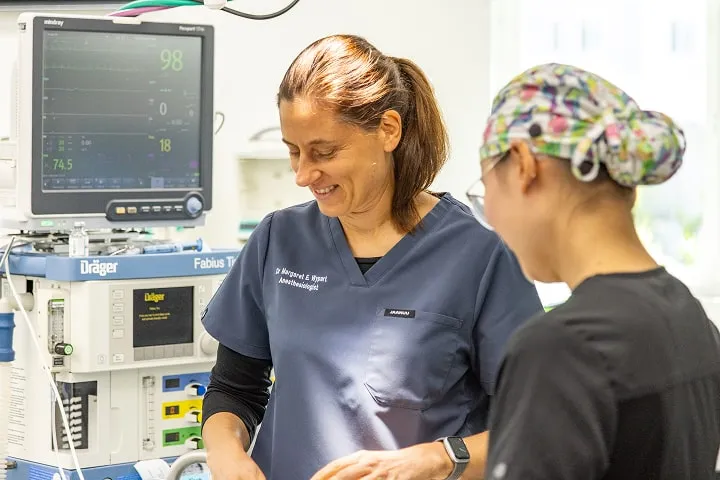

Ready to Give Your Pet the Best Care?
Schedule a consultation today and see why thousands of pet owners choose us.
Book in Just Minutes
Simple and hassle-free scheduling for your convenience.
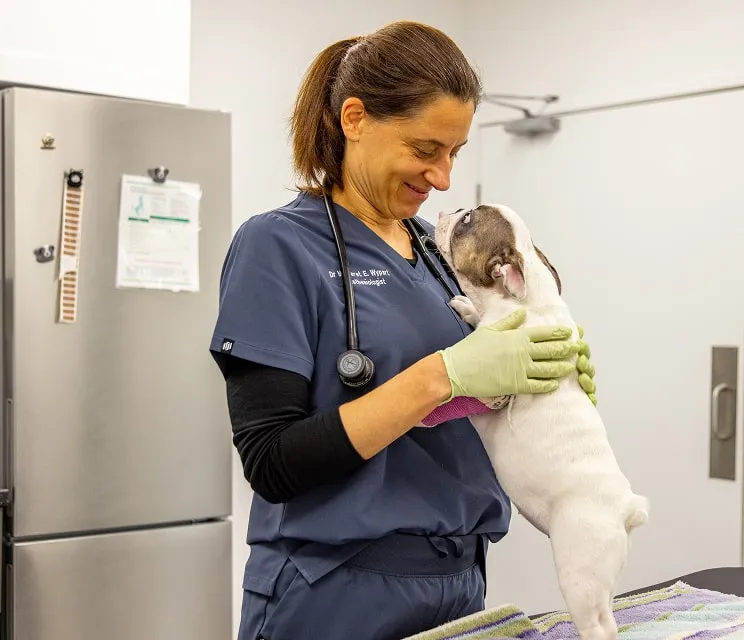
Have Questions? We’re Here to Help!

Elbow dysplasia is a condition caused by abnormal development of the elbow joint during puppyhood. The three bones that form the elbow - humerus, radius, and ulna - fail to align properly, creating uneven pressure within the joint.
This abnormal contact can lead to a range of issues, including loose cartilage, unstable bone fragments, and erosion of the joint surface. These changes cause pain, limping, and eventually arthritis.
Elbow dysplasia is one of the most common causes of front-leg lameness in young, large-breed dogs.
Common signs include:
- Lameness in a front leg, often mild at first
- Limping that is worse after exercise
- Limping that improves after a few days of rest
- Limping only after activity, or favoring affected leg often
- Waxing and waning symptoms with periods of normal use
- In more severe cases, holding the leg up and avoiding weight-bearing
- Stiffness especially in the morning
Canine elbow dysplasia is a congenital, hereditary disease that typically affects young dogs and is more common in certain breeds, including Labrador Retriever, Golden Retriever, Bernese Mountain, German Shepherd, Newfoundland, and Rottweiler.
The mal-alignment of the elbow joint bones causes abnormal pressure on the joint and repeated rubbing, which wears away the cartilage, resulting in severe osteoarthritis.
Elbow dysplasia in dogs can be treated with various options. Non-surgical methods include weight management, anti-inflammatory medications, and joint supplements. Physical therapy can also be very helpful for managing pain and improving movement.
For more severe cases, surgery might be the best option. Elbow dysplasia surgery is usually recommended when other treatments haven’t helped enough. The goal of surgery is to reduce pain, improve the dog’s movement, and slow down arthritis. The type of surgery depends on the severity and type of elbow dysplasia.
Elbow dysplasia surgery has a high success rate. Over 85% of dogs have significant improvement after surgery. The pain and limping resolve and they return to all pre-surgery activities. However, in dogs with severe or long-term elbow dysplasia, full recovery may take longer, and the dog may not regain complete normal function.
Yes, arthroscopy is less invasive, leads to faster healing, and provides a clearer view inside the joint, allowing for more precise treatment. However, in some cases, the procedure cannot be completed with arthroscopy alone, and a small open incision may still be needed to fully address the problem.
The surgeon will use a scope to examine the joint, remove damaged cartilage or bone fragments, and smooth rough surfaces to improve joint motion and comfort.
Most dogs recover well after elbow dysplasia surgery, especially when arthroscopy is used. Pain relief and improved joint function are common, and many dogs return to normal activity with an excellent quality of life.
Recovery typically takes a few months, with 4–8 weeks of restricted activity followed by gradual return to normal exercise. Physical therapy may be recommended in some cases to support strength and mobility.
Elbow dysplasia arthroscopy often costs $8,000–$10,000 at large hospitals in Southern California. At SurgiPet, our $4,850 flat fee (2025) covers all standard surgical costs - consults, anesthesia, board-certified anesthesiologist’s fees, OR, surgeon’s fee - plus extras often billed separately elsewhere, including:
- Pain meds, sedative, antibiotics, anti-nausea meds (for the first 2 weeks)
- Support sling to help your dog walk during early recovery
- All rechecks & X-rays for 4 months
- Sedation for X-rays if needed
- Pre-op bloodwork and chest films (if needed)
- Use of 4K Arthrex Synergy UHD4™ arthroscopy system
Not included: medications beyond two weeks (sedatives), surgical complications, CT scan or ultrasound (if needed), physical therapy, or rechecks beyond 4 months.
You’ll meet with both the surgeon and anesthesiologist in person to review the plan and ask any final questions. Your dog’s surgery is performed in a modern OR using Arthrex’s 4K Synergy UHD4™ arthroscopy system for exceptional joint visualization.
An anesthesiologist monitors your pet throughout, using advanced equipment and multimodal pain control. After surgery, your pet recovers in a quiet area under direct supervision. Most dogs are ready to go home by the evening - fully awake, comfortable, and sent home with meds, a support sling, and clear, personalized care instructions.


